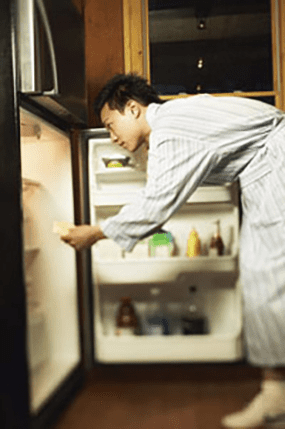When it comes to eating, many of us have developed habits. Some are good (“I always eat fruit as a dessert”), and some are not so good (“I always have a sugary drink after work as a reward”). Even if we’ve had the same eating pattern for years, it’s not too late to make improvements.
Making sudden, radical changes, such as eating nothing but cabbage soup, can lead to short term weight loss. However, such radical changes are neither healthy nor a good idea and won’t be successful in the long run. Permanently improving our eating habits requires a thoughtful approach in which we reflect, replace, and reinforce, the 3 Rs.

- REFLECT on all of our specific eating habits, both bad and good; and our common triggers for unhealthy eating.
- REPLACE our unhealthy eating habits with healthier ones.
- REINFORCE our new, healthier eating habits.
Reflect:
- Create a list of eating and drinking habits. Keep a food and beverage diary for a few days. Write down everything we eat and drink, including sugary drinks and alcohol. Write down the time of day we ate or drank the item. This will help us uncover our habits. For example, we might discover that we always seek a sweet snack to get through our mid-afternoon energy slump. It’s good to note how we were feeling when we decided to eat, especially if we were eating when we weren’t hungry. Were we tired? Were we stressed out?
- Highlight the habits on our list that may be leading us to overeat. Common eating habits that can lead to weight gain are:
- Eating too fast
- Always cleaning our plates
- Eating when we’re not hungry
- Eating while we’re standing up (may lead to eating mindlessly or too quickly)
- Always eating dessert
- Skipping meals (or maybe just breakfast)

- Look at the unhealthy eating habits we’ve highlighted. Be sure we’ve identified all the triggers that cause us to engage in those habits. Identify a few we’d like to work on improving first. Don’t forget to pat ourself on the back for the things we’re doing right. Maybe we usually eat fruit for dessert, or we drink low-fat or fat-free milk. These are good habits! Recognizing the successes will help in encouraging us to make more changes.
- Create a list of “cues” by reviewing our food diary to become more aware of when and where we’re “triggered” to eat for reasons other than hunger. Note how we are typically feeling at those times. Often an environmental “cue”, or a particular emotional state, is what encourages eating for non-hunger reasons. Common triggers for eating when not hungry are:
- Opening up the cabinet and seeing that favourite snack food.
- Sitting at home watching television.
- Before or after a stressful meeting or situation at work.
- Coming home after work and having no idea what’s for dinner.
- Having someone offer a dish they made “just for you!”
- Walking past a candy dish on the counter.
- Sitting in the break room beside the vending machine.
- Seeing a plate of doughnuts at the morning staff meeting.
- Swinging through the favourite drive-through every morning.
- Feeling bored or tired and thinking food might offer a pick-us-up.
- Circle the “cues” on our list that we face on a daily or weekly basis. While the Thanksgiving holiday may be a trigger to overeat, for now focus on cues we face more often. Eventually we’ll want a plan for as many eating cues as we can.
- Ask these questions for each “cue” we’ve circled:
- Is there anything we can do to avoid the cue or situation? This option works best for cues that don’t involve others. For example, could we choose a different route to work to avoid stopping at a fast-food restaurant on the way? Is there another place in the break room where we can sit so we’re not next to that vending machine?
- For things we can’t avoid, can we do something differently that would be healthier? Obviously, we can’t avoid all situations that trigger our unhealthy eating habits, like staff meetings at work. In these situations, evaluate the options. Could we suggest or bring healthier snacks or beverages? Could we offer to take notes to distract our attention? Could we sit further away from the food so it won’t be as easy to grab something? Could we plan ahead and eat a healthy snack before the meeting?
Replace:
- Replace unhealthy habits with new, healthy ones. For example, in reflecting upon our eating habits, we may realize that we eat too fast when we eat alone. So, make a commitment to share a lunch each week with a colleague, or have a neighbour over for dinner one night a week. Another strategy is to put our forks down between bites. Also, minimize distractions, such as watching the news while we eat. Such distractions keep us from paying attention to how quickly and how much we’re eating.
- Eat slower. If we eat too quickly, we may “clean our plates” instead of paying attention to whether our hunger has been satisfied.
- Eat only when we’re truly hungry instead of when we are tired, anxious, or feeling an emotion besides hunger. If we find ourself eating when we are experiencing an emotion besides hunger, such as boredom or anxiety, try to find a non-eating activity to do instead. We may find a quick walk or phone call with a friend helps us feel better.
- Plan meals ahead of time to ensure that we eat healthy well-balanced meals.

Reinforce:
- Reinforce our new, healthy habits and be patient. Habits take time to develop. It doesn’t happen overnight. When we do find ourselves engaging in an unhealthy habit, stop as quickly as possible and ask: Why are we doing this? When did we start doing this? What changes do we need to make? We must be careful not to berate ourselves or think that one mistake “blows” a whole day’s worth of healthy habits. We CAN do it! It just takes one day at a time!
Munchies4U does not provide professional dietary advice. If you or someone you care for has special dietary requirements, medical needs or an eating disorder, please seek advice from a registered healthcare professional.